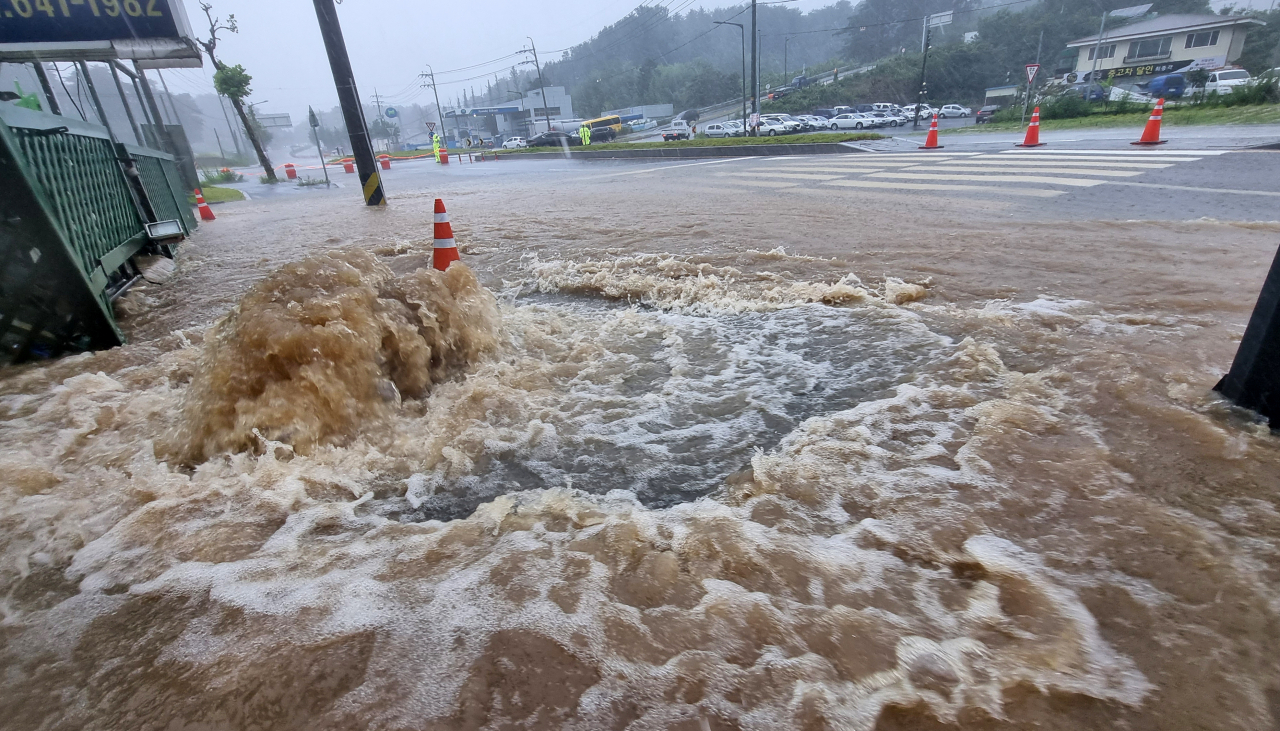Typhoon Khanun rampages through Korea
1 dead, 1 missing, over 10,000 displaced as Khanun moves up along Korean Peninsula
By Lee Jung-younPublished : Aug. 10, 2023 - 14:53

Typhoon Khanun made landfall on the Korean Peninsula Thursday morning, bringing heavy rain and strong winds across the country, leaving a trail of damage.
A 67-year-old man was found dead in a stream in Daegu at around 12:33 p.m. Thursday, according to the Daegu Fire Department. Separately, at around 1:45 p.m., a man in his 60s in an electric wheelchair in Dalseong-gun, Daegu, was swept away by the current and reported missing. Police and fire authorities deployed 100 personnel to track down the missing person.
The two incidents have not yet been counted as official typhoon casualties as of Thursday at 5 p.m.
Reports of damage continued as the entire country came under the influence of the typhoon.
A total of 10,641 people from 7,797 households nationwide were temporarily evacuated to shelters as of 11 a.m. Thursday, authorities said. Five were rescued by firefighters after becoming stranded by flooding in North Gyeongsang Province.
Police and firefighters were assigned to 12 underpasses and underground roads in the region to prevent accidents similar to the recent underpass flooding in Osong-eup, Cheongju, North Chungcheong Province, where 14 people died.
A total of 1,579 kindergartens and elementary, middle and high schools across the country have shifted to remote classes, closed or delayed school hours to ensure student safety.
Among the 3,333 educational institutions across the country that had ongoing classes, 47.4 percent have modified their schedules due to the typhoon. In particular, in North Gyeongsang Province, where the most rain and strong winds were forecast, all schools were closed.
The Ministry of Education will keep in place an emergency work system until the typhoon passes through Korea completely.
In order to reduce congestion on the way home from work, buses and subways run more frequently from 6 p.m. to 8 p.m. in Seoul. On Thursday, the hours were extended by 30 minutes as more traffic is expected.
At around 6 a.m. Thursday in Gumi, North Gyeongsang Province, a pine tree over 400 years old -- designated natural monument No. 357 -- was partially damaged due to strong winds. The tree has a height of 13.1 meters and a circumference of 4.05 meters.
According to the Interior Ministry, a total of 355 flights from 14 airports nationwide were canceled as of 11 a.m. Thursday. The Korea Railroad Corp., Korail, also said 161 high-speed trains and 251 regular trains have been suspended.
Heavy rain of 30 to 60 mm per hour hit in the east coast of Gangwon Province Thursday afternoon, causing flooding damage. As many roads were flooded, all available personnel -- including public officials, autonomous disaster prevention teams and police -- were mobilized to take emergency measures, but it is reported that they are having difficulty working due to the downpour accompanied by strong winds.
The Interior Ministry raised the typhoon crisis alert level to “serious” on Tuesday 5 p.m., the highest level among the four. A crisis alert level of “serious” is issued when large-scale damage is expected nationwide.
Khanun first hit the mainland near Geoje, South Gyeongsang Province, at 9:20 a.m. and passed 30 kilometers southeast of Chungju, North Chungcheong Province at 4 p.m., moving at a speed of 31 kilometers per hour. The typhoon was expected to stay on the Korean Peninsula for about 15 hours.
As of 4 p.m. Khanun was expected to move northward, passing through North Chungcheong Province and eastern Gyeonggi Province along its path toward North Korea. Khanun was likely to be the first typhoon to move across the entire peninsula from south to north since the Korea Meteorological Administration started keeping records in 1953.
Until just before landing, Khanun maintained its “strong” status, the third-highest category in the KMA‘s five-level system for categorizing typhoon strength, but when it landed, it weakened by a notch to “normal” due to friction with the ground. But according to the KMA, the typhoon was still so strong that it could blow the roof off of a building with its maximum wind speed of 25 meters per second to 33 meters per second.
As of 4 p.m. Thursday, Khanun‘s central atmospheric pressure and maximum wind speed were 985 hectopascals and 24 meters per second (or 86 kilometers per hour), respectively.
With typhoon advisories in effect in most parts of the country, the national weather agency predicted that the typhoon would bring very strong rainfall of 30 to 60 mm per hour in eastern Gangwon, North Gyeongsang and eastern South Gyeongsang Provinces. Rainfall of 10 to 30 mm per hour was expected in other regions.
The KMA also warned that very strong winds with a maximum instantaneous wind speed of 108 km per hour would strike the southern coast, Jeju Island, and the east coast of North Gyeongsang Province.
It will continue to rain in the central part of the Korean Peninsula until Friday and until early Saturday in the northwestern part of Gyeonggi Province, KMA reported.
The Central Disaster and Safety Countermeasures Headquarters sent out safety alert messages Thursday morning, urging everyone to stay indoors as much as possible and not to approach rivers, coastal areas, valleys and steep slopes.



















